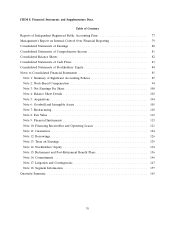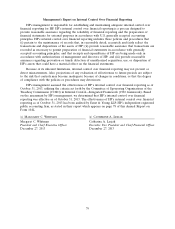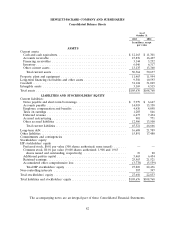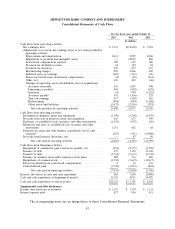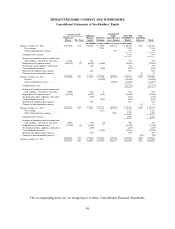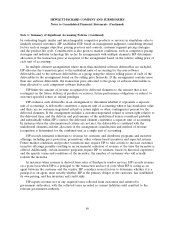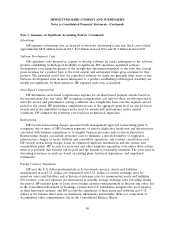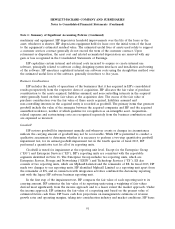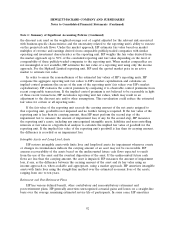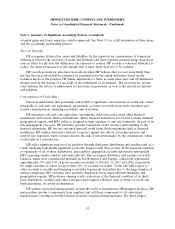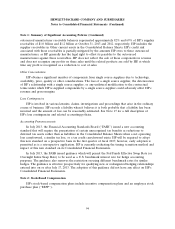HP 2013 Annual Report Download - page 93
Download and view the complete annual report
Please find page 93 of the 2013 HP annual report below. You can navigate through the pages in the report by either clicking on the pages listed below, or by using the keyword search tool below to find specific information within the annual report.HEWLETT-PACKARD COMPANY AND SUBSIDIARIES
Notes to Consolidated Financial Statements
Note 1: Summary of Significant Accounting Policies
Principles of Consolidation
The Consolidated Financial Statements include the accounts of Hewlett-Packard Company (‘‘HP’’)
and the subsidiaries and affiliates in which HP has a controlling financial interest or is the primary
beneficiary. HP accounts for equity investments in companies over which HP has the ability to exercise
significant influence but does not hold a controlling interest under the equity method, and HP records
its proportionate share of income or losses in Interest and other, net in the Consolidated Statements of
Earnings. HP presents non-controlling interests as a separate component within Total stockholder’s
equity in the Consolidated Balance Sheets. Net earnings attributable to the non-controlling interests are
eliminated within Interest and other, net in the Consolidated Statements of Earnings and are not
presented separately as they were not material for any period presented. HP has eliminated all
significant intercompany accounts and transactions.
Reclassifications and Segment Reorganization
HP has made certain segment and business unit realignments in order to optimize its operating
structure. Reclassifications of certain prior-year segment and business unit financial information have
been made to conform to the current-year presentation. None of the changes impacts HP’s previously
reported consolidated net revenue, earnings from operations, net earnings or net earnings per share.
See Note 18 for a further discussion of HP’s segment reorganization.
Use of Estimates
The preparation of financial statements in accordance with U.S. generally accepted accounting
principles (‘‘GAAP’’) requires management to make estimates and assumptions that affect the amounts
reported in HP’s Consolidated Financial Statements and accompanying notes. Actual results could
differ materially from those estimates.
Revenue Recognition
HP derives net revenue primarily from the sale of products and services. The following revenue
recognition policies define the manner in which HP accounts for sales transactions.
HP recognizes revenue when persuasive evidence of a sales arrangement exists, delivery has
occurred or services are rendered, the sales price or fee is fixed or determinable, and collectibility is
reasonably assured. Additionally, HP recognizes hardware revenue on sales to channel partners,
including resellers, distributors or value-added solution providers at the time of delivery when the
channel partners have economic substance apart from HP, and HP has completed its obligations related
to the sale. HP generally recognizes revenue for its stand-alone software sales to channel partners upon
receiving evidence that the software has been sold to a specific end user.
When a sales arrangement contains multiple elements, such as hardware and software products,
licenses and/or services, HP allocates revenue to each element based on a selling price hierarchy. The
selling price for a deliverable is based on its vendor specific objective evidence (‘‘VSOE’’) of selling
price, if available, third party evidence (‘‘TPE’’) if VSOE of selling price is not available, or estimated
selling price (‘‘ESP’’) if neither VSOE of selling price nor TPE is available. HP establishes VSOE of
selling price using the price charged for a deliverable when sold separately and, in rare instances, using
the price established by management having the relevant authority. HP establishes TPE of selling price
85



